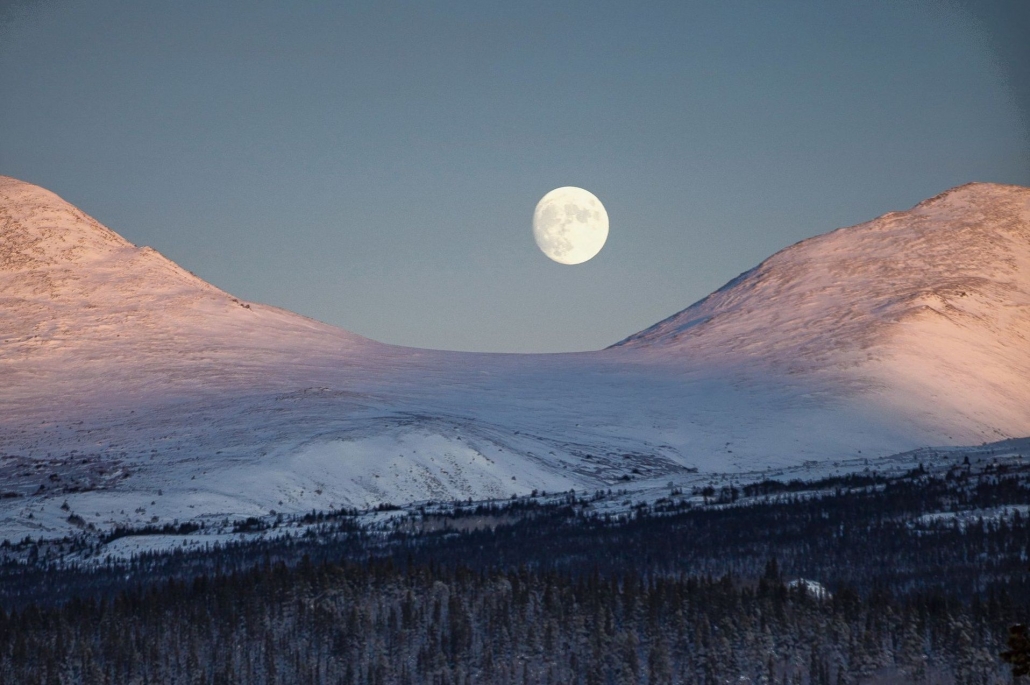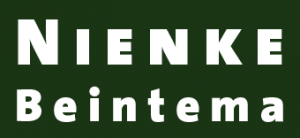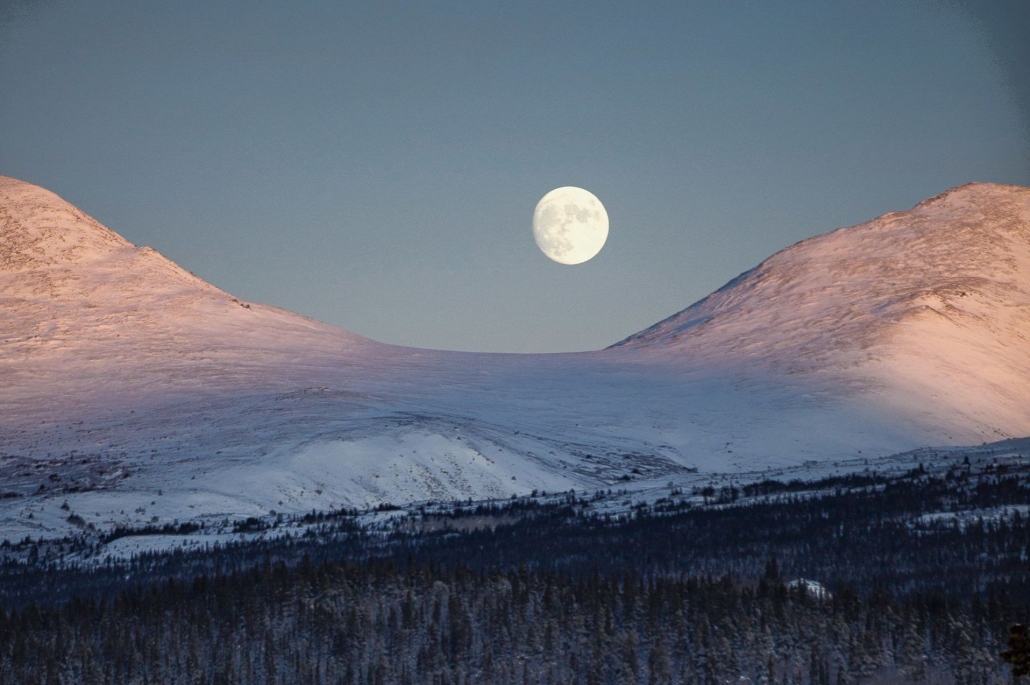Full-moon ski trip in Canada
A snowy landscape at full moon is a
silver-white fairytale world. It is almost as light as during the day, but you
don’t see any colours, you hardly hear any sounds. Gray shadows contrast sharply
with the sparkling snow.
I’m usually asleep then. Tonight I’ll stay up for it. My
friends Philippe Brient and Leandra Vos are going skiing with others, and I can
come along. We’ll go into the mountains near the Canadian village of Atlin, in
the remote border area with Alaska.
But now I am nervous because I have little experience on
skis. I pack my backpack very carefully: head lamp, balaclava, scarf, mittens.
First aid kit, satellite device, aluminum rescue blanket. Muesli bars, tea
thermos. Skis and poles in the back of the car.
We meet at eight pm, about twenty kilometers outside of
Atlin. Sunset was two hours ago and the moon is high in the sky. My companions
are already there. They check their equipment and stick “skins” under
their skis. Brient also sticks them under mine: narrow strips of fake fur that
let the skis slide in only one direction. This makes it easier to acsend on
skis. “And when you descend, they slow you down,” says Brient.
“Not a bad idea, for this trip.” I swallow.
Minor disappointment: the other inexperienced skier has
canceled. Remaining: five tough Canadians and one clumsy Dutchie.
Brient shoves a pile of things into my hands. “Here,
an avalanche set, for in your backpack.” A foldable probe to search for a
victim in the snow. A small shovel to dig the person out. And a signal-emitting
device that I hang around my waist. The device makes me findable when I’m buried
by snow. “Don’t worry,” says Brient. “There is hardly any
avalanche risk here. And Alastair here is pretty much the best-trained
avalanche rescuer in all of Western Canada. “
That’s convenient. In addition, Alastair Wain and companion
Steve Reid are both ambulance paramedics. Wain, Vos and Brient are also the
core of the local Search & Rescue, the professionally trained team that
detects and evacuates lost or injured mountaineers. I’m in safe hands.

We start out with a 15-minute snowmobile ride on a forest trail. I sit at the back of Vos’ machine and hold on tight. It is minus 15 and the wind pinches my cheeks. Several times I expect the snowmobile to slide sideways off the icy path, but Vos skilfully keeps a straight course.
By the time the snowmobiles stop, I am quite cold. Even so, I take off my sweater, because I don’t want to sweart during the ascent. We check whether all avalanche devices are working. We attach our skis and head lamps. The lamps remain switched off – there is plenty of moonlight. We’re ready to go.
Vos is the first to lead. It’s tough going: she has to plough through the knee-deep snow. ‘Breaking trail’, as they say here. Sometimes it is literally breaking through a hard snow crust. In other places, the snow is powdery-soft.
I ski right behind Vos. She keeps a good pace.
We follow an unpaved road that zigzags up the slope between high, narrow spruces. With every switchback the trees become lower and scarcer and the view becomes more breathtaking. Soon we see the elongated McDonald Lake below us, with Moose Mountain across the valley. Everything is silvery white. The full moon is decorating the sky like a radiant medal, shining from behind a thin veil of clouds.
We stop for a moment to drink tea. I pour a cup, scoop in some snow to cool it down, and drink it all at once. Another cup. I am sweating, despite the cold wind.
We descend steeply into a side valley. Miraculously, I haven’t fallen yet. The pale moonlight makes it hard to discern depth in the snow surface. You don’t see the bumps and pits before you hit them, which makes descending a challenge.
We cross the frozen stream, our ski poles squeaking on the ice, and climb up again on the other side, above the tree line, towards a rolling plateau. Here are meter-high snow ridges that we have to climb over, our skis and poles sticking out awkwardly. In other places all the snow has been blown away and we are skiing on pure ice. Mountain peaks are towering above us on the left. On the right, McDonald Lake has disappeared into the depths. Instead, we now see the frozen Atlin Lake far away on the left, vast and bright white in the moonlight.
On top of the plateau we see a network of animal trails and flattened resting spots. Round droppings, crescent-shaped hoofprints: caribou! The North American reindeer. They’re rare here. Apparently they have only just left, because the tracks are still fresh. It must have been a large group. I feel guilty: we probably scared them away. A waste of their energy, which they really cannot expend at this time of the year.
We start the descent almost unnoticed. Soon we are back under the tree line. Now it’s my turn to lead the way. We descend steeply, yet I have to struggle to advance, in snow that is literally knee-deep. Within a few minutes my heart thumps in my throat and I feel sweat running down my back again.
For a while I can ski in the tracks of a moose. That makes quite a difference: the moose has broken the trail. I am grateful to him. But a moment later his trail disappears straight down the slope, away from our path. I have to break my own trail again.
All of a sudden the path plunges steeply down. “Ambulance team standby!” Brient shouts, laughing. “Down you go.” I feign nonchalance and start the descent. The deep snow tampers my speed, which is good, but on the other hand it also throws me off balance, because it varies in hardness from place to place. This is no relaxed descent. Were I the last to ski here, in an open track, there’s no doubt I would go down the slope like a tumbleweed.
Left and right, the others glide past me, until we come to a halt at the bottom of a side valley. For a moment I hesitate to regain the lead. Let those strong rescue guys do that, I think to myself, quite gender-role confirming. But no, it is Vos who takes the lead again.
Animal tracks are everywhere. Foxes, coyotes, even a wolf. I also see a strange dragging trail. From a lynx with prey? But I see no blood or large paw prints anywhere. Only small ones. That must be it: the shuffling gait of a porcupine.
Suddenly I am alone. The rest has already disappeared in the dark spruce forest. Now it’s time to switch on my head lamp. The wind blows snow crystals from the trees and makes them swirl around my head. They tingle on my cheeks and sparkle in the light of my head lamp.
We descend faster and faster. Six headlamps now shine through the trees in different switchbacks, an almost symmetrical ballet of lights. I enjoy the swooshing sound of the gliding skis. My ears pop because of the altitude drop. Cramp in my foot due to continuous braking. Moping ski. Tree root. Snow pile. Down in the snow at last! Snow is creeping between my jacket and ski pants, against my bare back. I scrambled to my feet. Melt water starts running towards my bum. I smile broadly.
We’re all back down unscathed. I have no sense of time. Someone says: “Exactly midnight!” If he had said “Half past two,” I would have believed him. It is a strange time vacuum, a nightly trip like this. Quickly I take off my skis, put on an extra layer of clothes and get onto the back of the snowmobile. The cold wind is entering my wet shirt from all directions. I crawl behind the downy jacket of Vos, who is not bothered by anything. The toughest woman in the world.


/s3/static.nrc.nl/bvhw/files/2019/03/data42708778-96f820.png)